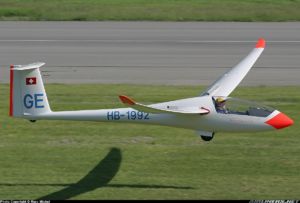PlaneSpottingWorld welcomes all new members! Please gives your ideas at the Terminal.
Schempp-Hirth Ventus
| A Ventus C on final approach. | |
| Type designation | Ventus |
| Competition class | 15 metre |
| Year | 1980-1994 |
| Number built | 613 + |
| Crew | 1 |
| Length | 6.35 m (Ventus A) 6.58 m (Ventus B/C) |
| Height | 1.30 m |
| Cockpit width | 0.54 m (Ventus A) 0.62 m (Ventus B/C) |
| Cockpit height | 0.75 m (Ventus A) 0.81 m (Ventus B/C) |
| Wingspan | 15/16.6 m (Ventus A/B) 15/17.6 m (Ventus C) |
| Wing area | 9.51 m² (15 m) 9.96 m² (16.6 m) 10.14 m² (17.6 m) |
| Aspect ratio | 23.7 (15 m) 27.7 (16.6 m) 30.5 (17.6 m) |
| Wing profile | FX 79-K-144 |
| Empty mass | 214 kg (Ventus A 15 m) 225 kg (Ventus B 15 m) 228 kg (16.6 m) 246 kg (17.6 m) |
| Water ballast | 160 kg |
| Maximum mass | 525 kg (15 m) 430 kg (16.6 m) 500 kg (17.6 m) |
| Wing loading | 33 - 54 kg/m² (15 m) 32 - 43 kg/m² (16.6 m) 32 - 48 kg/m² (17.6 m) |
| Maximum speed | 250 km/h |
| Rough air speed | |
| Minimum sink rate | 0.59 m/s at 80 km/h (15 m) 0.53 m/s at 80 km/h (16.6m) |
| Best glide ratio (Idaflieg) | ca. 44 (Ventus A 15 m) ca. 43 (Ventus B 15 m) ca. 46 (Ventus A 16.6 m) |
| Roll rate | 4.5 s from -45º to +45º bank (flap +8º) |
The Schempp-Hirth Ventus is a sailplane produced by Schempp-Hirth between 1980 and 1994. It replaced the Mini-Nimbus. It was designed by Klaus Holighaus.
Carbon fibre had become less expensive and so the whole wing was made of carbon reinforced plastic. A new thinner wing section was also developed. In addition to the 15 metre span complying with the Racing Class, longer tips were available to increase the span to 16.6 metres. Two fuselage sizes were produced, the Ventus A is the narrow version and the Ventus B is the wider version. Winglets have been retro-fitted to many As and Bs. The best measured glide ratio at 15 metres is 44:1 but with the 16.6 metre tips the ratio improved to 46:1 (50:1 according to one source).
Both the A and B have the complex flap/brake arrangement of the Mosquito and the Mini-Nimbus, but the later Ventus C has conventional air-brakes, separate from the flaps. The optional tips in the Ventus C can extend the span to 17.6 metres (16.6 metres in the A and B versions). Some Ventus Bs and Cs are fitted with small sustaining engines (turbos) and are designated with a T while some are self-launching and have an M.
The Ventus won two World Gliding Championships in competition with the Alexander Schleicher ASW 20 and later the Rolladen-Schneider LS6. The Ventus A and B acquired a reputation for unparalleled high speed glide performance, at the cost of some unpleasant handling characteristics. Handling was improved in the C model.
Over 613 Ventus A and B and an unspecified number of Ventus C were built until they were replaced in 1995 by the Schempp-Hirth Ventus 2.
Sources
- Johnson R,
A FTE of the Ventus A, Soaring, December 1981
A FTE of the Ventus B, Soaring, June 1982
A FTE of the 16.6m Ventus, Soaring, April 1984 - Thomas F, Fundamentals of Sailplane Design, College Park Press, 1999
- Simons M, Segelflugzeuge 1965-2000, Eqip, 2004
- Specifications of Schempp-Hirth Ventus
Lists relating to aviation | |
|---|---|
| General | Timeline of aviation · Aircraft · Aircraft manufacturers · Aircraft engines · Aircraft engine manufacturers · Airports · Airlines |
| Military | Air forces · Aircraft weapons · Missiles · Unmanned aerial vehicles (UAVs) · Experimental aircraft |
| Notable incidents and accidents | Military aviation · Airliners · General aviation · Famous aviation-related deaths |
| Records | Flight airspeed record · Flight distance record · Flight altitude record · Flight endurance record · Most produced aircraft |

